
A digital camera is a camera that captures photographs in digital memory. Most cameras produced today are digital, largely replacing those that capture images on photographic film. Digital cameras are now widely incorporated into mobile devices like smartphones with the same or more capabilities and features of dedicated cameras. High-end, high-definition dedicated cameras are still commonly used by professionals and those who desire to take higher-quality photographs.

An autofocus optical system uses a sensor, a control system and a motor to focus on an automatically or manually selected point or area. An electronic rangefinder has a display instead of the motor; the adjustment of the optical system has to be done manually until indication. Autofocus methods are distinguished as active, passive or hybrid types.

A digital single-lens reflex camera is a digital camera that combines the optics and the mechanisms of a single-lens reflex camera with a solid-state image sensor and digitally records the images from the sensor.

Super CCD is a proprietary charge-coupled device that has been developed by Fujifilm since 1999. The Super CCD uses octagonal, rather than rectangular, pixels. This allows a higher horizontal and vertical resolution to be achieved than a traditional sensor of an equivalent pixel count.

Image stabilization (IS) is a family of techniques that reduce blurring associated with the motion of a camera or other imaging device during exposure.
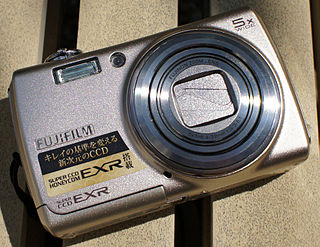
The FujifilmFinePix F series is a line of compact digital cameras that was known for its low-light performance in 2005, with relatively low image noise and natural colors even at high ISO settings. With its relatively large, but moderate resolution Super CCD sensors, it concentrated on image quality, and low-light shooting without flash, which was mostly restricted to prosumer models at the time.

The Fujifilm FinePix products are a line of digital cameras produced by Fujifilm. They include compact point and shoot models, tough, waterproof models, bridge digital cameras, digital SLRs and mirrorless cameras. Many use Fujifilm's proprietary Super CCD technology sensors and CMOS sensors for high-end models.

The Panasonic Lumix DMC-GH1 is a digital mirrorless interchangeable lens camera adhering to the Olympus and Panasonic developed Micro Four Thirds System (MFT) system design standard. Panasonic classified the GH1 as a hybrid stills/video camera and the GH1 was introduced and marketed as a higher end camera than Panasonic's first MFT camera, the stills only, non-video capable Lumix DMC-G1.
The Fujifilm FinePix S200EXR is a digital bridge camera from Fujifilm introduced in July 2009.

The Fujifilm FinePix HS10 is an ultrazoom bridge camera from Fujifilm that was announced in February 2010. It is the first model of the Fujifilm FinePix HS series.

The Fujifilm X series is a line of digital cameras produced by Fujifilm. The series encompasses fixed lens and interchangeable lens mirrorless cameras and premium compact point-and-shoot cameras aimed at consumer, enthusiast and professional photographers. The X series is part of the larger FinePix range of digital cameras from Fujifilm.
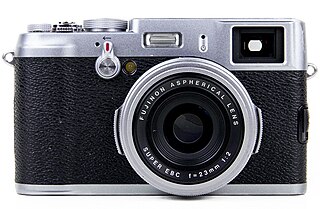
The Fujifilm X100 is a series of digital compact cameras with a fixed prime lens. Originally part of the FinePix line, then becoming a member of the X series from Fujifilm, the X100 series includes the FinePix X100,X100S,X100T,X100F, and X100V. They each have a large image sensor and a 23 mm lens. All five cameras have received generally positive reviews.
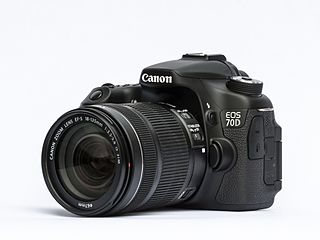
The Canon EOS 70D is a digital single-lens reflex camera by Canon publicly announced on July 2, 2013 with a suggested retail price of $1,199. As a part of the Canon EOS two-digit line, it is the successor to the EOS 60D and is the predecessor of the EOS 80D.

The Fujifilm X-E2 is a digital rangefinder-style mirrorless camera announced by Fujifilm on October 18, 2013. An updated version with minor improvements of the camera, called the Fujifilm X-E2s, was announced on January 15, 2016. Both cameras are part of the company's X-series range of cameras.

The Fujifilm FinePix HS50EXR is a DSLR styled ultra-zoom bridge camera announced by Fujifilm on January 7, 2013. It is the last model of the Fujifilm FinePix HS series. At the time of its release, it competed most closely with the Canon PowerShot SX50 HS, another ultra-zoom bridge camera with raw capability. The SX50 has 20% longer maximum effective focal length, but the HS50 has 33% more resolution on the sensor.

The Fujifilm X10 is a 2/3 sensor digital compact camera announced by Fujifilm on September 1, 2011. At the time of its release, it competed most closely with the Panasonic Lumix DMC-LX5, Olympus XZ-1, Canon PowerShot G1 X and Sony Cyber-shot DSC-RX100, and was subsequently named a 2013 iF product design award recipient.
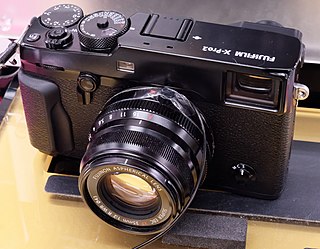
The Fujifilm X-Pro2 is a mirrorless interchangeable-lens digital camera announced in January 2016. It is part of Fujifilm's X-Series of cameras, the successor to the X-Pro1. Sales began on 3 March 2016.
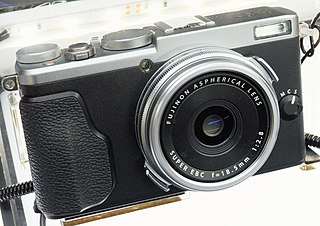
The Fujifilm X70 is an APS-C sensor digital compact camera with an 18.5 mm fixed prime lens. It is part of Fujifilm's X-Series of cameras. It was announced in January 2016 and was released on 18 February 2016.

















